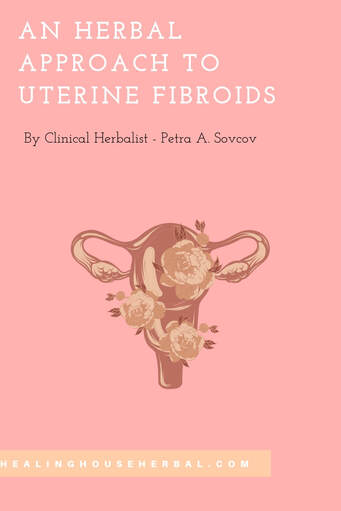|
As seen in Home Herbalist Magazine Many discussions on female health can be plagued with uncertainty and unanswered questions, especially in western culture where access to more natural means may not be readily discussed in a modern doctor’s office. This of course, in my opinion, is not due to any maliciousness on the practitioner’s part, but rather that these types of options are not yet fully embraced as a partnered path to healing in modern western medicine. I think that in modern times, it is often forgotten that Herbalism is the oldest healing modality known to man and has a rich history of traditional use. In the spirit of learning, it is my full intention to offer an understanding of this female reproductive issue from the standpoint of modern western medicine as described in medical texts, and to share the more common herbal, supplemental, lifestyle, and dietary allies that are readily available. Due to the fact that this is indeed a clinical issue, I have not included a full herbal protocol as each individual is different and their needs will be different. Please contact a clinical herbalist if you would like to explore the option of herbal medicine, and continue to work with your medical doctor. Understanding Uterine Fibroids: Uterine fibroids (also known as Leiomyoma of the uterus or just Myoma) are the most common type of tumor of the genital tract. They are bundles of smooth muscle and connective tissue, surrounded by a thin capsule that can be as small as a pea or in some cases, as large as a grapefruit. Although they are sometimes referred to as tumors, fibroids are considered non-cancerous. However, because they disrupt the blood vessels and glands in the uterus like a tumor, they are spoken of in these relative terms. Uterine Fibroids are generally classified by their location in the uterus, these are:
Causes: Current medical science has not yet determine the actual cause of uterine fibroids, some of the theories are that they occur with genetic changes, hormone imbalances (fibroids contain more estrogen and progesterone receptors than normal uterine muscle cells), and other growth factors (other hormones or external factors that might affect the bodies substances that maintain healthy tissues – possibly xenoestrogens). Despite medical science not having a clear understanding of the mode of cause, it is known that fibroids do require high estrogen levels as a mechanism to grow. Concentrations of estrogen receptors are higher in fibroid tissue than in the surrounding tissue. In addition to an excess of estrogen production within the body, a strong case can be made for the role of the most significant environmental factor assaulting female hormonal health – as discussed earlier, these compounds are known as xenoestrogens. These compounds are endocrine/hormone disruptors, environmental estrogens, hormonally active agents, estrogenic substances, estrogenic xenobiotics, and bioactive chemicals. Examples of xenoestrogens include phthalates (used in most plastics), pesticides and herbicides, tobacco smoke and by-products, and various solvents (think about your common household cleaners). Xenoestrogens enhance or block the effects of estrogen in the body by binding to estrogen receptors. They also promote a shift from healthy estrogen breakdown products to cancer-causing estrogen metabolites in some people. Lastly, another theory is that chronic use of the birth control pill can also contribute to the growth of fibroids. It is also common to see fibroids shrink after menopause. A Brief commentary on phytoestrogens (plant based estrogens): Phytoestrogens are able to bind to the same cell receptors as the estrogen your body produces. That’s a very good thing, because when phytoestrogens occupy the receptors, estrogen can’t affect cells. By competing with estrogen, phytoestrogens cause a drop in estrogen effects, and are thus sometimes called “antiestrogens”. Great sources of phytoestrogens include organic, non-processed soy, ground organic flax seed, and organic nuts and seeds. In particular, it is recommended to have 1 to 2 tablespoons of ground flaxseed daily. On the opposing view, some have suggested that since soy foods are high in phytoestrogens (specifically isoflavones), which have a weak estrogenic effect, women with uterine fibroids or endometrial cancer should avoid phytoestrogens. This recommendation has not stood up to clinical trial. Soy isoflavones appear to be selective in terms of tissues in which they have an estrogenic effect and the tissues in which their effect is antiestrogenic. Soy phytoestrogens do not appear to have an estrogenic effect on the human uterus and may in fact help shrink uterine fibroids due to an antiestrogenic effect. It is recommended to have moderate, but not excessive soy consumption in the range of 45 to 90mg of soy isoflavones per day, you can find this in a standardized capsule if needed, but again, be mindful of processing. Common symptoms of uterine fibroids:
Complications of uterine fibroids:
Natural Suggestions for uterine fibroids:
Commonly Used Herbs:
Commonly Used Supplements:
I hope you have found information of value in this article, and that the richness of our herbal allies show once again that for man-kind’s maladies, nature has supplied us with a remedy. In health and wellness, -Petra References:
7 Comments
Danita Dyess
3/10/2021 07:42:38 pm
This was an excellent, comprehensive post. You turned a complex subject into something I can understand and apply immediately. Thank you for a job well done.
Reply
Paula Harris
12/8/2021 12:14:26 pm
Uterine fibroid: I am seeking. A natural liquid supplement to dissolve/shrink uterine fibroid (naturally).
Reply
3/2/2022 08:53:57 pm
Thank You for Sharing this informative article! I really like to visit your Product review. It is very useful to everyone Stay healthy and keep safe!
Reply
3/15/2022 06:26:06 am
I very much appreciate it. Thank you for this excellent article. Keep posting!
Reply
Leave a Reply. |
Petra Sovcov is not a Medical Doctor (MD) nor a Naturopath (ND), she is a Clinical Herbal Therapist (CHT) and holds a Doctorate in Natural Medicine (DNM). The suggestions or recommendations made on this site are not meant to be a substitute for advice from your MD, or as a substitute for any prescriptions you may be taking. Suggestions followed will be the responsibility of the reader, and are stated with the intention of interest and education only. If you have a health issue, please see your primary care physician (MD) first and foremost. Categories
All
Archives
July 2024
|


 RSS Feed
RSS Feed